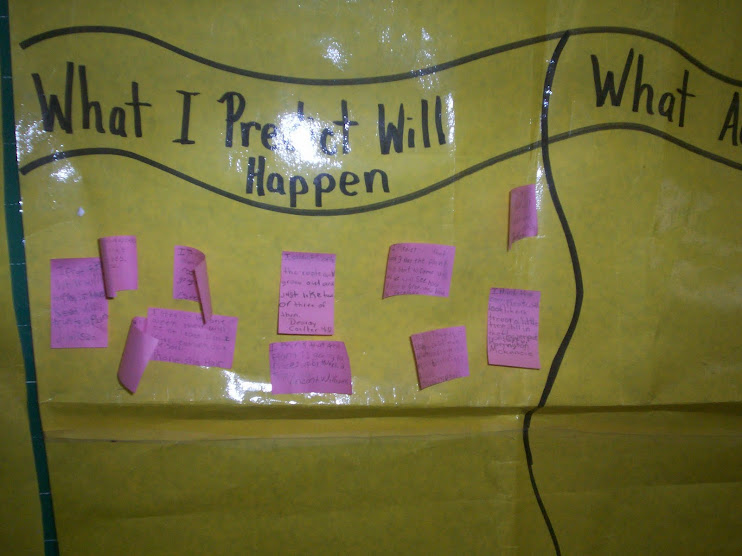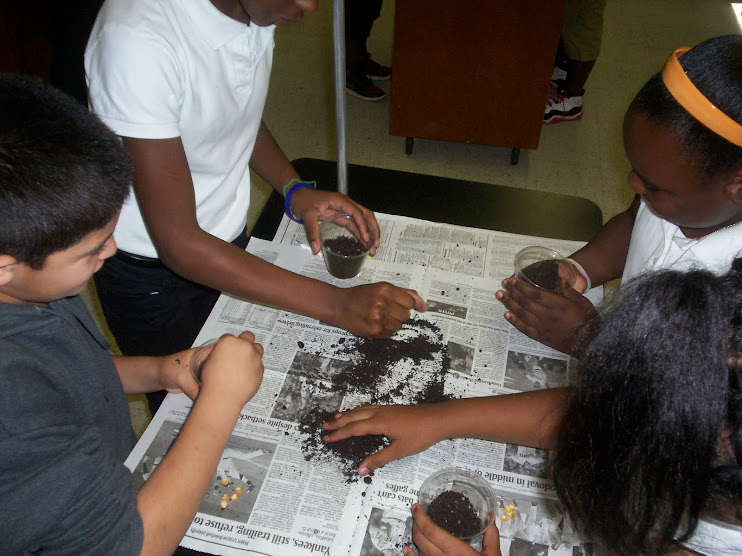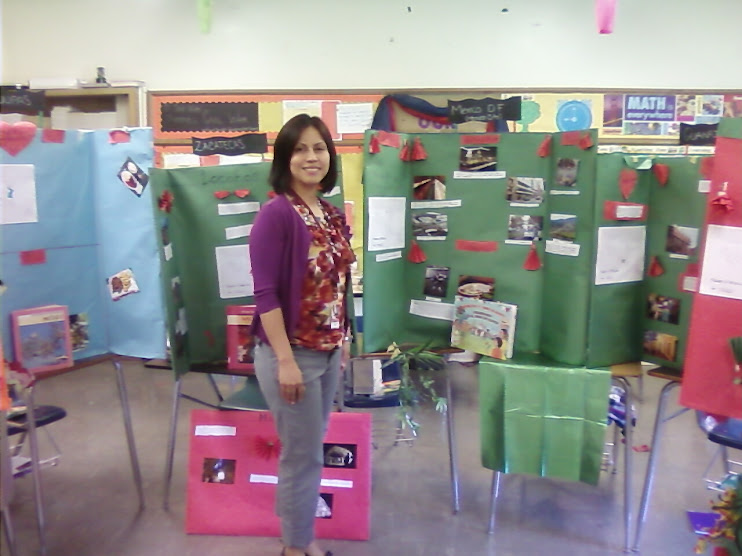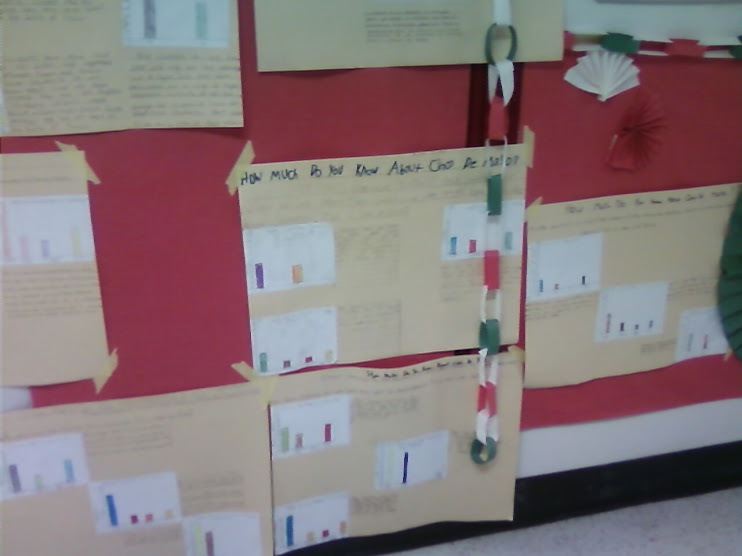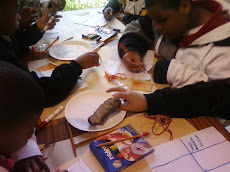Tuesday, April 27, 2010
The Final Report-Apr. 27, 2010
It is amazing how building a strong phonetic base, coupled with whole language skills can increase a child's vocabulary, and reading ability with consistant effort on part of the teacher. During this case study, students who spelled phonetically, needed dictionary or referencing skill building. Others just simply became better readers, and writers. In closing, there is no doubt in my mind that small grouping, and differentiated instruction helps us understand how lesson's need to be taylored in order to suite student needs.
Tuesday, April 20, 2010
Apr. 20,2010 Reflection
Today in class, we shared one thing that we were proud of regarding our blogs. Reflecting back on our individual struggles in creating the blog, we overcame and stepped up to the challenge. this class has increased our confidence as Educators because we are able to do something that most of our collegues are not able to do regarding technology.
In sharing out about our respective case studies, we found that spending one on one time, and working in small group instruction helped us dig deeper into getting to know our students. Delving in to their knowledge base has proved to be a valuable resource when developing lessons that reach their inner spirits.
In closing, I must declare that the Teacher using technology increases efforts to step away from the traditional way of teaching, and incorporate technology in his/her classroom and lesson planning.
In sharing out about our respective case studies, we found that spending one on one time, and working in small group instruction helped us dig deeper into getting to know our students. Delving in to their knowledge base has proved to be a valuable resource when developing lessons that reach their inner spirits.
In closing, I must declare that the Teacher using technology increases efforts to step away from the traditional way of teaching, and incorporate technology in his/her classroom and lesson planning.
Monday, April 19, 2010
Apr. 6, 2010 Reflection
What I reflected on in tonight's session was that constructing and maintaining student engagement throught any lesson comes through monitoring student comprehension, and retention of taught materials. What was reinforced was that these processes must be reciprocal. The teacher and reader must give and take while learning. Meaning, the student is expected to demonstrate and model instruction.
Friday, April 16, 2010
Mar. 9, 2010 Reflection
The saga continues. We have now started our individual case studies and are beginning to truly understand that we must be multi-sensory teachers and meet the child where he/she is. One of our classmates, whom is a Reading Coach for the Dallas Independent School District, shares that she is beginning to approach her student of case study from a karate stand point because that is his primary interest. She has begun to apply what we’ve known as educators all along…that is, reach one, and teach one. She shared her excitement in fashioning lessons that would peek hi interest from a karate point of view.
I began my contribution to the class by adding that my 2nd grade student that I had begun tutoring back in January of this year is beginning to show some level of improvement. What I’ve observed in him, is that he needs short mini lessons that home in on his weak areas of reading retention, vocabulary, and comprehension. I’m also starting to detect that he may have attention problems that might impede upon his progress in a large group setting. To offset this dilemma, I started incorporating technology via the suggestion of Ms. Andrea Timmons, a 1st grade Teacher in Dallas ISD. She recommends that Starfall.com is one of the best interactive ways to teach phonetics and decoding skills in kid friendly way.
All I can say is, stay tuned. We will see how this works in a few more weeks.
I began my contribution to the class by adding that my 2nd grade student that I had begun tutoring back in January of this year is beginning to show some level of improvement. What I’ve observed in him, is that he needs short mini lessons that home in on his weak areas of reading retention, vocabulary, and comprehension. I’m also starting to detect that he may have attention problems that might impede upon his progress in a large group setting. To offset this dilemma, I started incorporating technology via the suggestion of Ms. Andrea Timmons, a 1st grade Teacher in Dallas ISD. She recommends that Starfall.com is one of the best interactive ways to teach phonetics and decoding skills in kid friendly way.
All I can say is, stay tuned. We will see how this works in a few more weeks.
Mar. 2, 2010 Reflection
Reflection 2
The purpose of the session today was to brainstorm our case study topic and focus. We each reflected back on prior classes that helped us fashion the Introduction, Purpose, and Problem of the study. Consequently, the discussion led to the fact that the State was preparing for the TAKS Writing test for 4th and 7th graders, in turn, we began to discuss Writing and Literacy; which prompted me to continue my focus for my case study on ESL, and Phonics vs. Whole Language.
Prior to this course, our group actually had the opportunity to begin preparing a case study as if we were prepping for a Master’s Thesis. What a wonderful blessing and peace of mind it was to have already started this process. For my case study, I will continue to take look at how building a strong phonemic foundation for both the General Ed. Student and the ESL learner are critical; and how whole language should not be the primary foundation of beginning literacy.
What I embraced from this session, is that building a web blog will be challenging, but it must be done. Although I am no technological genius, I will definitely try my best to step up to the challenge.
The purpose of the session today was to brainstorm our case study topic and focus. We each reflected back on prior classes that helped us fashion the Introduction, Purpose, and Problem of the study. Consequently, the discussion led to the fact that the State was preparing for the TAKS Writing test for 4th and 7th graders, in turn, we began to discuss Writing and Literacy; which prompted me to continue my focus for my case study on ESL, and Phonics vs. Whole Language.
Prior to this course, our group actually had the opportunity to begin preparing a case study as if we were prepping for a Master’s Thesis. What a wonderful blessing and peace of mind it was to have already started this process. For my case study, I will continue to take look at how building a strong phonemic foundation for both the General Ed. Student and the ESL learner are critical; and how whole language should not be the primary foundation of beginning literacy.
What I embraced from this session, is that building a web blog will be challenging, but it must be done. Although I am no technological genius, I will definitely try my best to step up to the challenge.
Feb. 27, 2010 Reflection
Today’s session at the Dallas Public Library proved to be fruitful. Dr. Vowels felt it necessary to ensure that we developed a solid foundation for building, and being able to access information to create our web blogs. I was intrigued because I had previously gotten started on my web blog via www.merlot.org, one of the most leading network sources for Educators who want to develop, and create a professional portfolio via technology. The purpose of today’s visit to the library was to reinforce our understanding in how to access free, public resources that can aid in our constructing the course case study on the web blog.
The “Wow” moments for me were when we took a tour of the library’s temporary wing for the children’s section, and found that the upper level loft was under construction for the location, and that there will be over 10,000 books, tools, resources, and new technologies that children all over the metroplex will have access to. Another “Wow” moment was to see were the bubble domes. I’ve never seen anything like these. They looked like creations from the Cartoon, The Jetson’s. The domes hung overhead, were made of fiber glass, and allowed one to hear music only under the shield of the bubble. Oddly enough, no one standing near are far could hear the sounds underneath….Amazing.
What I gained from this Saturday’s session, were wonderful websites that will appear under the “Presentation” section of my Merlot web blog. Interactive sites such as www.bookflix.com at http://bkflix.grlier.com/pb/node-32748, and DPL Resources For Teachers at www.dallaslibrary2.org/educators , proved to be advantageous Teacher resources.
The “Wow” moments for me were when we took a tour of the library’s temporary wing for the children’s section, and found that the upper level loft was under construction for the location, and that there will be over 10,000 books, tools, resources, and new technologies that children all over the metroplex will have access to. Another “Wow” moment was to see were the bubble domes. I’ve never seen anything like these. They looked like creations from the Cartoon, The Jetson’s. The domes hung overhead, were made of fiber glass, and allowed one to hear music only under the shield of the bubble. Oddly enough, no one standing near are far could hear the sounds underneath….Amazing.
What I gained from this Saturday’s session, were wonderful websites that will appear under the “Presentation” section of my Merlot web blog. Interactive sites such as www.bookflix.com at http://bkflix.grlier.com/pb/node-32748, and DPL Resources For Teachers at www.dallaslibrary2.org/educators , proved to be advantageous Teacher resources.
Wednesday, April 14, 2010
Processes Used For Case Study
Processes:
• Read fluently.
• Engage in discussions around text using Accountable Talk.
• Learn and use new words.
• Locate main idea(s) and supporting details.
• Use a text’s structure, such as cause-effect or comparison-contrast, to get meaning from text.
• Understand characteristics of genres: informational article and biography.
• Interpret and construct graphic organizers containing important information from text.
• Correctly apply the conventions of English when writing.
• Write effectively to communicate a persuasive composition.
• Continue to establish the norms of a literacy learning community based on the Principles of Learning.
• Facilitate Accountable Talk around “Communication”.
• Use small groups to differentiate reading and writing instruction.
• Guide students to identify cause-effect relationships and create graphic organizers to represent them.
• Monitor student fluency.
• Read aloud to students daily, choosing from both narrative and expository texts.
• Guide students to identify main idea and supporting details and create graphic organizers to represent them.
• Provide multiple exposures to unfamiliar terms, including word walls, personal dictionaries, and authentic writing tasks.
• Facilitate students’ use of prewriting strategies to select a topic and organize ideas for a persuasive composition.
• Guide students to design criteria charts for a persuasive composition.
• Scaffold students as they compose a persuasive composition.
• Confer with students throughout the writing process.
• Listen actively to teacher read alouds.
• Respond orally and in a reader response journal to texts heard and read.
• Participate in the creation of criteria charts for folktales, expository writing, and conventions.
• Participate in creating graphic organizers for compare and contrast and main idea with details.
• Read instructional-level texts with fluency.
• Maintain a personal dictionary.
• Use context and structural analysis to solve unknown words.
• Use metacognitive processes to comprehend text.
• Use text coding to aid in comprehension of text.
• Contribute to discussions focused on the theme “Communication”.
• Use graphic organizers to support Accountable Talk.
• Participate in discussions focused on compare and contrast and main idea with details.
• Use prewriting strategies to select a topic for a persuasive narrative.
• Produce a draft of a persuasive composition.
• Complete Major Tasks which leads to a culminating project.
• Students will create graphic organizers and other visual scaffolds to enhance comprehension of texts.
• Students will design and employ criteria charts and rubrics to measure their growth.
• The class will maintain and add to a word wall to scaffold acquisition of new vocabulary.
• Students will maintain personal dictionaries containing both instructional and personally meaningful vocabulary.
• Students will maintain a reader response journal.
• Students will code texts (using sticky notes if necessary).
• Students will post concepts, questions, articles, pictures, etc. related to “Communication.
• Students will create a culminating project.
• Student writing products will provide evidence of their growth in communicating ideas through writing.
• Read fluently.
• Engage in discussions around text using Accountable Talk.
• Learn and use new words.
• Locate main idea(s) and supporting details.
• Use a text’s structure, such as cause-effect or comparison-contrast, to get meaning from text.
• Understand characteristics of genres: informational article and biography.
• Interpret and construct graphic organizers containing important information from text.
• Correctly apply the conventions of English when writing.
• Write effectively to communicate a persuasive composition.
• Continue to establish the norms of a literacy learning community based on the Principles of Learning.
• Facilitate Accountable Talk around “Communication”.
• Use small groups to differentiate reading and writing instruction.
• Guide students to identify cause-effect relationships and create graphic organizers to represent them.
• Monitor student fluency.
• Read aloud to students daily, choosing from both narrative and expository texts.
• Guide students to identify main idea and supporting details and create graphic organizers to represent them.
• Provide multiple exposures to unfamiliar terms, including word walls, personal dictionaries, and authentic writing tasks.
• Facilitate students’ use of prewriting strategies to select a topic and organize ideas for a persuasive composition.
• Guide students to design criteria charts for a persuasive composition.
• Scaffold students as they compose a persuasive composition.
• Confer with students throughout the writing process.
• Listen actively to teacher read alouds.
• Respond orally and in a reader response journal to texts heard and read.
• Participate in the creation of criteria charts for folktales, expository writing, and conventions.
• Participate in creating graphic organizers for compare and contrast and main idea with details.
• Read instructional-level texts with fluency.
• Maintain a personal dictionary.
• Use context and structural analysis to solve unknown words.
• Use metacognitive processes to comprehend text.
• Use text coding to aid in comprehension of text.
• Contribute to discussions focused on the theme “Communication”.
• Use graphic organizers to support Accountable Talk.
• Participate in discussions focused on compare and contrast and main idea with details.
• Use prewriting strategies to select a topic for a persuasive narrative.
• Produce a draft of a persuasive composition.
• Complete Major Tasks which leads to a culminating project.
• Students will create graphic organizers and other visual scaffolds to enhance comprehension of texts.
• Students will design and employ criteria charts and rubrics to measure their growth.
• The class will maintain and add to a word wall to scaffold acquisition of new vocabulary.
• Students will maintain personal dictionaries containing both instructional and personally meaningful vocabulary.
• Students will maintain a reader response journal.
• Students will code texts (using sticky notes if necessary).
• Students will post concepts, questions, articles, pictures, etc. related to “Communication.
• Students will create a culminating project.
• Student writing products will provide evidence of their growth in communicating ideas through writing.
Tuesday, April 13, 2010
April 13, 2010 Reflection
In tonight's session, our class engaged in a discusion on one of my favorite topics which serves as the backdrop for my case study on phonics vs. whole language in working with student groups A, and D. The visiting professor stressed the impotance of creating a print rich environment, and building a strong phonetic foundation for the ESL student, and surprisingly for some African-American students that also have language difficiancies.
The most important keypoint of the session was that educators must be multi-sensory in terms of differentiating instruction. It is highly important for the educator to delve into the student's background in order to understand how to teach or reach the student. This means that we must understand that cookie-cutter techniques, and ditto sheets galore wont cut it. One size does NOT fit all.
To summarize tonight's class, we (educators) must make each student feel as if they are our favorite. We must continue to meet the needs of the student where they are. In applying the discussion professionally, while continuing to develop my case study with Groups A and D, I must remain sensitive to my students' needs.
The most important keypoint of the session was that educators must be multi-sensory in terms of differentiating instruction. It is highly important for the educator to delve into the student's background in order to understand how to teach or reach the student. This means that we must understand that cookie-cutter techniques, and ditto sheets galore wont cut it. One size does NOT fit all.
To summarize tonight's class, we (educators) must make each student feel as if they are our favorite. We must continue to meet the needs of the student where they are. In applying the discussion professionally, while continuing to develop my case study with Groups A and D, I must remain sensitive to my students' needs.
Subscribe to:
Posts (Atom)
